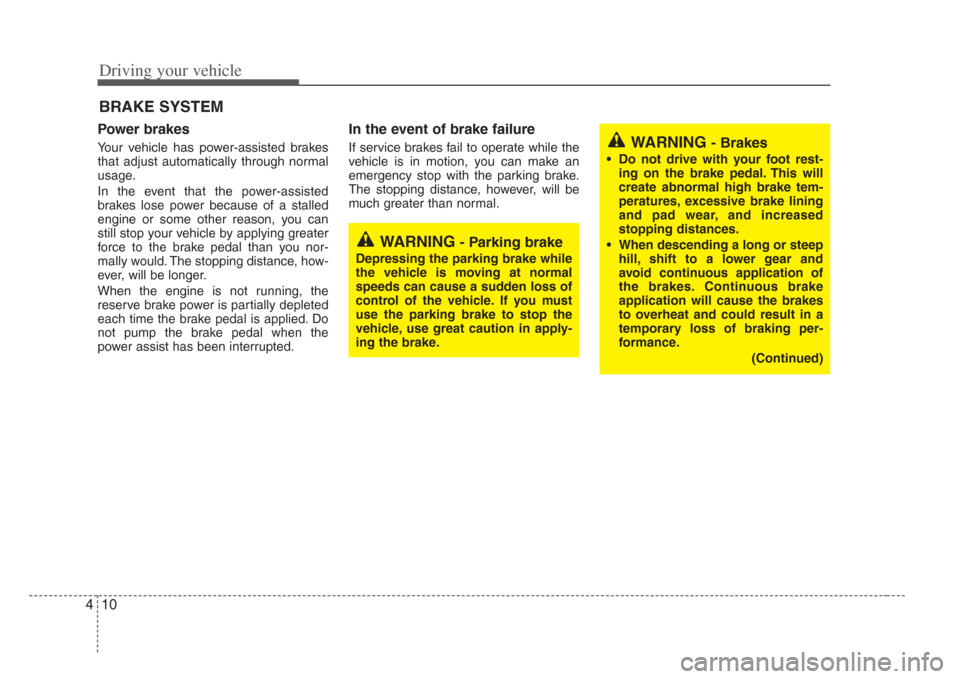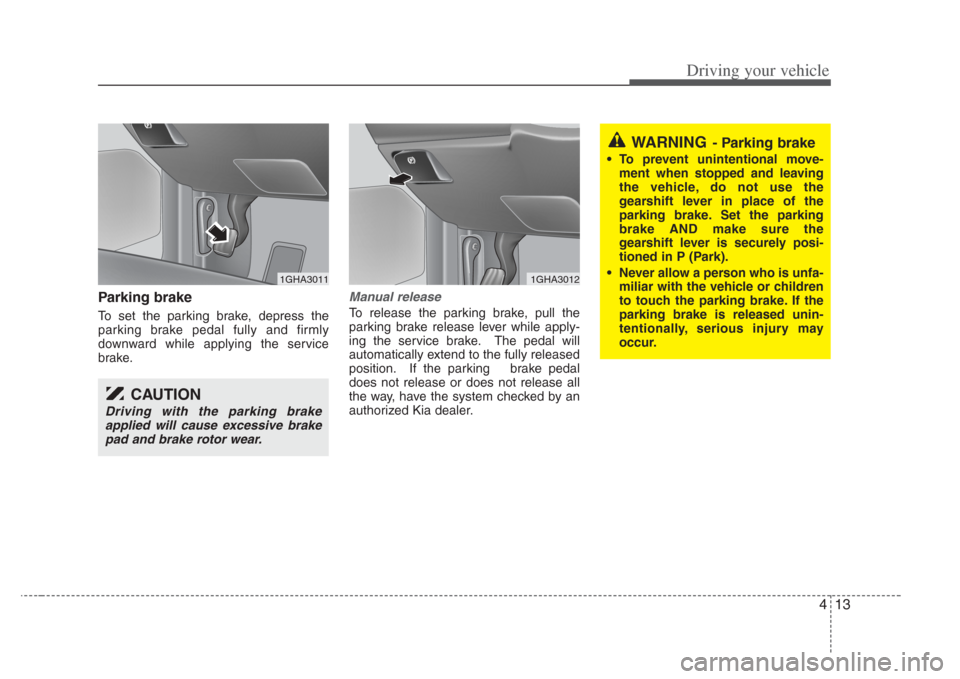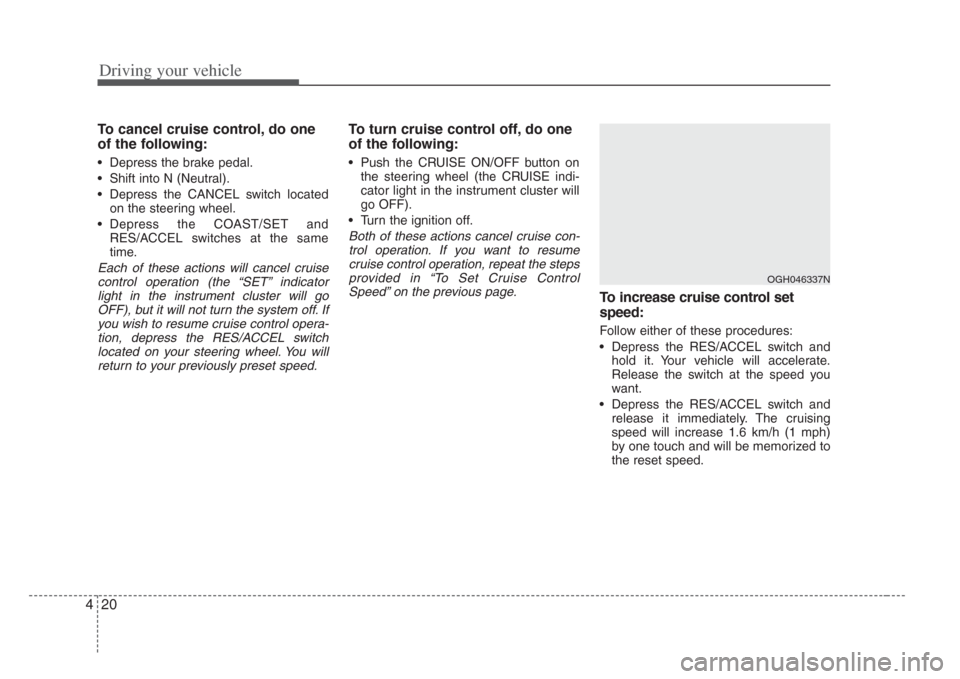Page 141 of 283

Driving your vehicle
104
Power brakes
Your vehicle has power-assisted brakes
that adjust automatically through normal
usage.
In the event that the power-assisted
brakes lose power because of a stalled
engine or some other reason, you can
still stop your vehicle by applying greater
force to the brake pedal than you nor-
mally would. The stopping distance, how-
ever, will be longer.
When the engine is not running, the
reserve brake power is partially depleted
each time the brake pedal is applied. Do
not pump the brake pedal when the
power assist has been interrupted.
In the event of brake failure
If service brakes fail to operate while the
vehicle is in motion, you can make an
emergency stop with the parking brake.
The stopping distance, however, will be
much greater than normal.
BRAKE SYSTEM
WARNING- Parking brake
Depressing the parking brake while
the vehicle is moving at normal
speeds can cause a sudden loss of
control of the vehicle. If you mu st
use the parking brake to stop the
vehicle, use great caution in apply-
ing the brake.
WARNING - Brakes
• Do not drive with your foot re st-
ing on the brake pedal. Thi s will
create abnormal high brake tem-
peratures, excessive brake lining
and pad wear, and increas ed
stopping di stances.
• When descending a long or steep hill, shift to a lower gear and
avoid continuous application of
the brakes . Continuous brake
application will cause the brakes
to overheat and could re sult in a
temporary loss of braking per-
formance.
(Continued)
Page 142 of 283

411
Driving your vehicle
Disc brakes wear indicator
Your vehicle has disc brakes.
When your brake pads are worn and it's
time for new pads, you will hear a high-
pitched warning sound from your front
brakes or rear brakes. You may hear this
sound come and go or it may occur
whenever you depress the brake pedal.
Please remember that some driving con-
ditions or climates may cause a brake
squeal when you first apply (or lightly
apply) the brakes. This is normal and
does not indicate a problem with your
brakes.
✽NOTICE
To avoid costly brake repairs, do not
continue to drive with worn brake pads.
WARNING- Brake wear
This brake wear warning s ound
means your vehicle needs service.
If you ignore this audible warning,
you will eventually lose braking per-
formance, which could lead to a
serious accident.
CAUTION
Always replace brake pads a s com-
plete front or rear axle sets.
(Continued)
• Wet brakes may result in the vehi- cle not to slow down at the usual
rate and make it pull to one side
when the brakes are applied.
Applying the brake s lightly will
indicate whether they have been
affected in this way. Always test
your brakes in this fashion after
driving through deep water. To
dry the brakes, apply them lightly
while maintaining a safe forward
s peed until brake performance
returns to normal.
Page 143 of 283

Driving your vehicle
124
Power adjustable pedals
(if equipped)
To adjust the position of the accelerator
and brake pedals, turn the ignition key to
the “ON” position with the selector lever
in the "P" position and push the switch.
If you push the “ ▲” portion of the switch,
the pedals move rearward.
If you push the “ ▼” portion of the switch,
the pedals move forward.
Setting the driver' s position
1. Be sure the parking brake is engaged.
2. Move the accelerator and brake ped-
als to the front most position by push-
ing the “ ▼” portion of the switch.
3. Adjust the seat position and the steer- ing wheel angle properly.
4. Move the pedals toward you until you can fully depress the brake pedal by
pushing the “ ▲” portion of the switch.
5. Depress the pedals a few times to get used to the feel after adjusting.
OGH026050N
WARNING - Pedal adju st-
ment
• Adjust the pedals after parking
the vehicle on level ground. Never
attempt to adjust the pedals while
the vehicle i s moving.
• Never adjust the pedals with your foot on the accelerator pedal as
this may result in increasing the
engine speed and acceleration.
• Make sure that you can fully
depress the brake pedal before
driving. Otherwi se, you may not
be able to hold down the brake
pedal firmly in an emergency
stop.
Page 144 of 283

413
Driving your vehicle
Parking brake
To set the parking brake, depress the
parking brake pedal fully and firmly
downward while applying the service
brake.
Manual release
To release the parking brake, pull the
parking brake release lever while apply-
ing the service brake. The pedal will
automatically extend to the fully released
position. If the parking brake pedal
does not release or does not release all
the way, have the system checked by an
authorized Kia dealer.
CAUTION
Driving with the parking brakeapplied will cause excessive brakepad and brake rotor wear.
1GHA30111GHA3012
WARNING- Parking brake
• To prevent unintentional move- ment when stopped and leaving
the vehicle, do not us e the
gear shift lever in place of the
parking brake. Set the parking
brake AND make s ure the
gear shift lever is securely posi-
tioned in P (Park).
• Never allow a per son who is unfa-
miliar with the vehicle or children
to touch the parking brake. If the
parking brake is released unin-
tentionally, serious injury may
occur.
Page 145 of 283

Driving your vehicle
144
Check the brake warning light by turning
the ignition switch ON (do not start the
engine). This light will be illuminated
when the parking brake is applied with
the ignition switch in the START or ON
position.
Before driving, be sure the parking brake
is fully released and the brake warning
light is off.If the brake warning light remains on
after the parking brake is released, there
may be a malfunction in the brake sys-
tem. Immediate attention is necessary.
If at all possible, cease driving the vehi-
cle immediately. If that is not possible,
use extreme caution while operating the
vehicle and only continue to drive the
vehicle until you can reach a safe loca-
tion or repair shop.
Parking on curbed streets
• When parking your vehicle on an uphill
grade, park as close to the curb as
possible and turn the front wheels
away from the curb so that the front
wheels will contact the curb if the vehi-
cle moves backward.
• When parking your vehicle on a down- hill grade, park as close to the curb as
possible and turn the front wheels
toward the curb so that the front
wheels will contact the curb if the vehi-
cle moves forward.
W-75
Page 146 of 283

415
Driving your vehicle
Anti-lock brake system (ABS)The ABS system continuously senses
the speed of the wheels. If the wheels are
going to lock, the ABS system repeated-
ly modulates the hydraulic brake pres-
sure to the wheels.
When you apply your brakes under con-
ditions which may lock the wheels, you
may hear a “tik-tik’’ sound from the
brakes, or feel a corresponding sensation
in the brake pedal. This is normal and it
means your ABS system is active.
In order to obtain the maximum benefit
from your ABS system in an emergency
situation, do not attempt to modulate
your brake pressure and do not try to
pump your brakes. Press your brake
pedal as hard as possible or as hard as
the situation warrants and allow the ABS
system to control the force being deliv-
ered to the brakes.• Even with the anti-lock brake system,
your vehicle still requires sufficient
stopping distance. Always maintain a
safe distance from the vehicle in front
of you.
• Always slow down when cornering. The anti-lock brake system cannot pre-
vent accidents resulting from exces-
sive speeds.
• On loose or uneven road surfaces, operation of the anti-lock brake system
may result in a longer stopping dis-
tance than for vehicles equipped with a
conventional brake system.
WARNING- ABS Brakes
Your ABS is not a substitute for
good driving judgement. You can
still have an accident. In fact, your
ABS system will probably not be
able to prevent an accident in the
following driving condition s:
• Dangerous driving,such as
neglecting safety precautions ,
speeding, or driving too clo se to
the vehicle in front of you.
• Driving at high speed in situa- tions providing considerably less
traction, such as wet conditions
where hydroplaning could occur.
• Driving too fast on poor road sur- faces. The ABS is designed to
improve maximum braking effec-
tiveness on typical highway s and
roads in good condition. On poor
road surfaces in poor condition,
the ABS may actually reduce
braking effectivene ss.
Page 147 of 283

Driving your vehicle
164
✽NOTICE
If the ABS warning light is on and
stays on, you may have a problem
with the ABS system. In this case,
however, your regular brakes will
work normally.
The ABS warning light will stay on for approximately 3 seconds after the
ignition switch is ON. During that
time, the ABS will go through self-
diagnosis and the light will go off if
everything is normal. If the light stays
on, you may have a problem with your
ABS system. Contact an authorized
Kia dealer as soon as possible.
✽ NOTICE
When you drive on a road having
poor traction, such as an icy road, and
operate your brakes continuously, the
ABS will be active continuously and
the ABS warning light may illuminate.
Pull your car over to a safe place and
stop the engine.
Restart the engine. If the ABS warn- ing light is off, then your ABS system
is normal. Otherwise, you may have a
problem with the ABS. Contact an
authorized Kia dealer as soon as pos-
sible.
✽ NOTICE
When you jump start your vehicle
because of a drained battery, the engine
may not run as smoothly and the ABS
warning light may turn on at the same
time. This happens because of the low
battery voltage. It does not mean your
ABS is malfunctioning.
Do not pump your brakes!
Have the battery recharged before
driving the vehicle.
ABS
W-78
Page 151 of 283

Driving your vehicle
204
To cancel cruise control, do one
of the following:
• Depress the brake pedal.
• Shift into N (Neutral).
• Depress the CANCEL switch locatedon the steering wheel.
• Depress the COAST/SET and RES/ACCEL switches at the same
time.
Each of these actions will cancel cruisecontrol operation (the “SET” indicator light in the instrument cluster will goOFF), but it will not turn the system off. Ifyou wish to resume cruise control opera-tion, depress the RES/ACCEL switch located on your steering wheel. You willreturn to your previously preset speed.
To turn crui se control off, do one
of the following:
• Push the CRUISE ON/OFF button on
the steering wheel (the CRUISE indi-
cator light in the instrument cluster will
go OFF).
• Turn the ignition off.
Both of these actions cancel cruise con- trol operation. If you want to resumecruise control operation, repeat the stepsprovided in “To Set Cruise ControlSpeed” on the previous page.
To increas e cruise control s et
s peed:
Follow either of these procedures:
• Depress the RES/ACCEL switch and
hold it. Your vehicle will accelerate.
Release the switch at the speed you
want.
• Depress the RES/ACCEL switch and release it immediately. The cruising
speed will increase 1.6 km/h (1 mph)
by one touch and will be memorized to
the reset speed.
OGH046337N